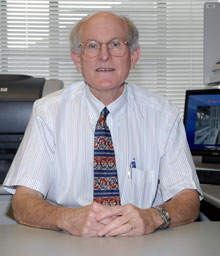  |
| HOME | THIS ISSUE | CALENDAR | GRANTS | BACK ISSUES | < BACK | NEXT > |
Engineering professor monitors safety of Connecticut bridgesby Nan Cooper - September 17, 2007 | ||||
| The Minneapolis bridge collapse, which sent cars and trucks plummeting 60 feet into the Mississippi River during the evening rush hour on Aug. 1, brought the nation’s bridges into the spotlight. Behind the scenes for many years, a UConn professor of engineering has been working to help ensure the safety of Connecticut’s bridges. John DeWolf, a professor of civil and environmental engineering, has spent more than two decades on field research involving the monitoring of bridges in the state. In 1985, he began research aimed at learning how existing technologies can be used to monitor in-service bridges on a variety of performance criteria, and how bridges perform and age over time. Bridge safety is something most people take for granted. But the Minneapolis bridge collapse reminded Americans that parts of the nation’s increasingly decaying infrastructure require attention and regular repair. Connecticut’s last bridge collapse took place in 1983, when a 100-foot portion of I-95 spanning the Mianus River in Greenwich crumbled, killing three people. The state has come a long way since that time, partly due to DeWolf’s efforts. In carrying out their research, DeWolf and his team selected a cross-section of the state’s most important bridges and paired them with different sensor systems to determine which provided the most useful and reliable information. Each monitoring array is custom-tailored, based on the inspection concerns, traffic, age, and materials specific to the bridge. The monitoring apparatus includes a computer and hardware that operates various sensors. The data are collected at intervals and stored in the computer, from which they can be accessed remotely. DeWolf uses sophisticated finite element analysis to make sense of the raw data. The resulting profile is then compared against the field inspection results. The points of convergence or deviation allow him to refine his analytical model and examine differences, to glean a better understanding of bridge behavior. DeWolf conducts both short-term and long-term monitoring studies. He says the short-term monitoring is meant to complement the state’s inspection system, and is conducted on selected bridges that have been targeted for some type of repair.
“For example, if inspectors find a crack, we can help them determine more precisely the nature of the problem and how it can be addressed for optimal safety while avoiding unnecessary repair costs,” he says. The National Bridge Inspection Standards call for every public bridge to be inspected a minimum of every two years. Currently, inspectors examine and rate bridges based on a “visual condition” rating system, with values ranging from 9 (best score) to 0 (worst). Since these ratings are observation-based, rather than discrete measurements, they involve a fair degree of subjectiveness. DeWolf’s studies involve quantifying metrics that reduce the subjective nature of the inspections and enhance bridge safety. DeWolf has used as many as 52 sensors on any one bridge, and as few as 14. The arrays may include a combination of tilt meters, accelerometers, strain gauges, and thermocouples that measure tilt, vibration, strain, and temperature at various locations on a bridge. He currently has long-term monitoring arrays installed on six Connecticut bridges. His objective with these long-term monitoring studies is to better understand how bridges perform and degrade over time, under different weather and temperature conditions, with varying use, and to develop assessment guidelines that can be applied uniformly and universally. “We have learned a great deal about how bridges perform over time. Our field research has allowed us to develop techniques for structural health monitoring of bridges that can be applied broadly to assess the bridge infrastructure,” he says. One of the new systems his team deployed is the first of its kind: an array that relies on solar panels for its power source. The introduction of solar energy will improve the team’s ability to keep an array in place and capture critical data over long periods. |
| ADVANCE HOME UCONN HOME |

